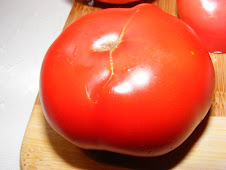I'm gonna jump off track here and skip ahead to saving seeds. I was going through my seed inventory, and realized that I have just over 50 varieties of tomatoes now. To some that may seem like a lot, and to others, a piddling amount. Almost half are from the plants that I grew last year and saved seed from, so I decided that was my next topic.
Saving seeds is very simple, but if you really want to be sure that you have a pure strain, and that no cross pollination has occurred, then you have to start the process before the flower on the tomato plants are even open. Cross pollination occurs when one variety is pollinated by another. Most of our varieties are the results of natural crosses, usually done by insects, which have over time become 'stable'. Hybrids are the result of man-made crosses. The offspring of such a cross is an F1 (first generation), and that is what you are buying when you buy a hybrid. You can save the seeds from an F1, which would be F2 (second generation), but you won't get the same plant as the original F1, which is not to say you may not get a nice tomato out of it. And experimenting can be fun. It can get pretty technical, and there's a lot of interesting information out there about tomato breeding, stabilizing hybrid offspring, trying to grow the parents back out, etc, but that's not where I was going with this.
There are a couple ways to ensure the tomato seeds will be pure. Bagging blossoms, maintaining isolation distances, or if you're not interested in saving seeds, but want certain varieties, then make sure you buy from a reputable seller. There are also many traders out there, who take it pretty seriously, and folks who only want to ensure these varieties keep growing, who will give away seeds for the price of a stamp! They are serious about this endeavor, and will most likely have done the work to ensure pure seeds.
Bagging blossoms is your best bet whether you are growing a small or large variety of OP's. You simply cover the flowers before they open, using a light weight material such as cut up nylon from stockings, or tulle. It basically provides a physical barrier to prevent any insects or wind blown pollen coming in contact with the flowers. Giving the flowers a gentle shake is a good idea. Tomatoes are self pollinating, having perfect flowers, which means they contain both the male and female part of the flower. They do need pollen in order to form fruit, but they provide it themselves. Once they have start to form the fruit, remove the bag and identify those particular ones with string or warn, so that you remember to harvest the seeds from those tomatoes. As a home gardener, you don't need a huge amount of saved seed, so a few tomatoes should provide you with enough seed.
So now we'll assume you have the tomatoes that you want to save the seeds from in hand. You chopped them in half and squished out the seeds. They are covered in a gelatinous goo, and you will need to ferment them in order to remove it, which also help in removing any pathogens or bacteria. I use a small kitchen glass, add the seeds and a bit of water, give it a stir and put it on my kitchen windowsill. It only take a day or two, stirred once or twice a day, and they should be done. You don't want to leave them too long, or they may end up sprouting in the water and then they are no good at all. Most of the seed will have sunk to the bottom of the glass. Strain them in a tea strainer, or similar, giving them a really good rinse. Then simply dump them out on a paper towel, fold it up and leave it out to dry. Make sure you label the paper towel, because you will forget what variety they are in a week or two, if you have more than one type on the go. Once they are completely dry, pack them away in a cool dark place. Voila, you have seeds for next year.
skip to main |
skip to sidebar

Growing heirloom tomatoes from seed
Welcome to NakedTomatoes
All about tomatoes, heirloom and home grown.
With a bit extra thrown in about Brugs and bread, growing and baking, and other semi-relevant thoughts. And maybe a few recipes.
With a bit extra thrown in about Brugs and bread, growing and baking, and other semi-relevant thoughts. And maybe a few recipes.
Followers
Aylmer Internet Gardening Club
I've set up a proboard, which is basically a place to chat, and leave messages, for other Aylmer gardeners. Let's see if we can make it work as gardening club too.
Who am I? Who who...

gardening sites and forums
Blogs of Note..by friends, gardeners, or just noteworthy
My Wordpress Blog
Book/Author Recommendations
- Carl Hiaasen
- Christopher Moore
About Me
- sammy
- I am an passionate gardener, and love to share this passion with my children and others who have the bug. I have many other interests, but hope to make a living someday out of my love of gardening. I am also an avid reader, love to bake and cook, hate laundry and housework(who doesn't??), love to stay up late and sleep in (which doesn't mesh with my real life responsibilities), love all kinds of music, play the violin, and have quite the collection of instruments, and I think my neighbors believe I am the 'crazy cat lady' there are quite a few living here. Anyway, that's just a bit about me. ... Any errors in the descriptions or any thing else are unintentional, and probably my fault.
No comments:
Post a Comment